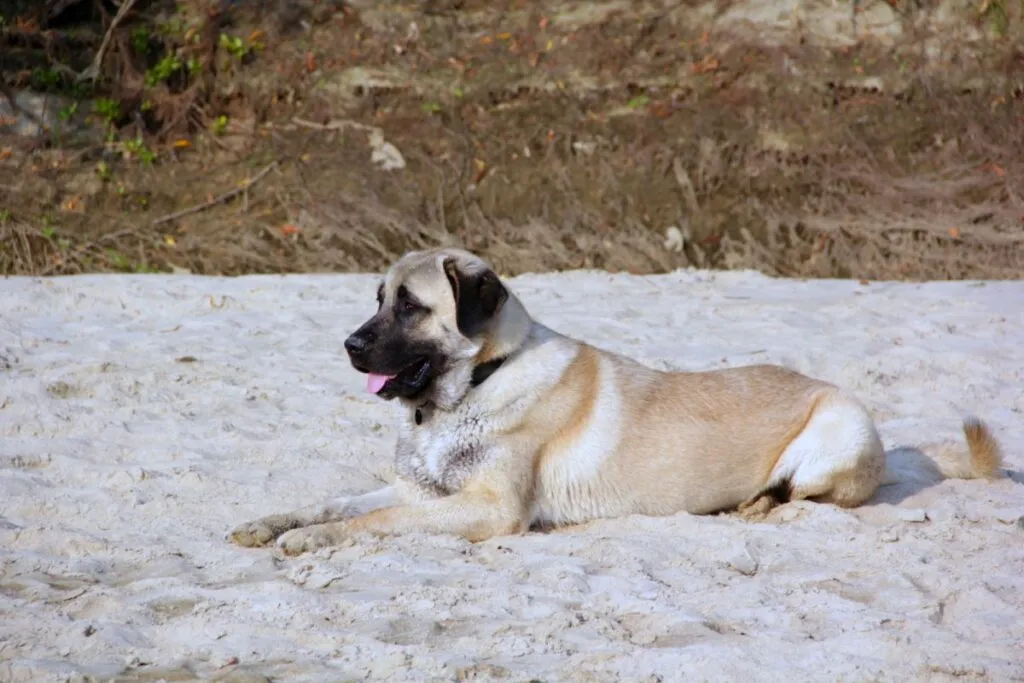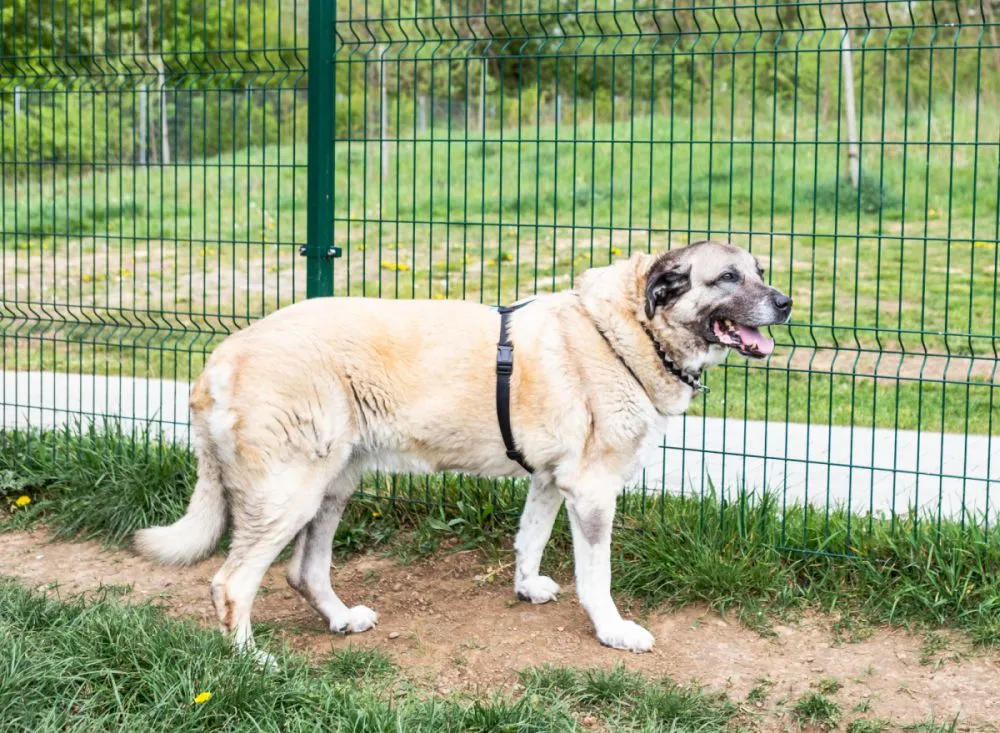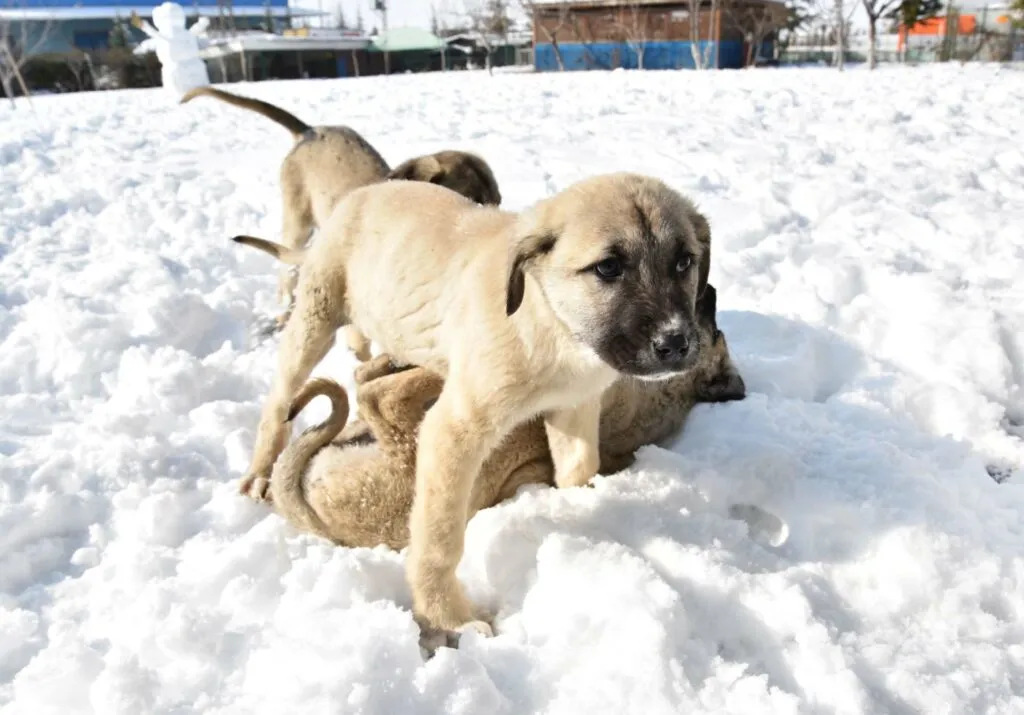Medium Size Poodle
Up until 2018, the FCI recognised the Anatolian Shepherd Dog as a distinct breed. Then, the Kangal found its place on the breed list. Unlike the Anatolian Shepherd Dog, the Kangal is bred pure in Turkey. Let's introduce this majestic dog.

© K.Bry / stock.adobe.com
The Kangal is a proud beauty with high demands for care
A Kangal impresses at first sight – quite literally with its imposing size. This dog exudes strength and muscle, which is also reflected in its movements. When necessary, it can move with lightning speed.
Its broad head is framed by hanging ears. The long rod reaches down to its hocks and curls over its back when excited. At ease, the Kangal carries it relaxed, hanging, and slightly curled.
Males reach a height of 74 to 81cm at the withers and can weigh up to 65kg. Females are slightly smaller at 71 to 79cm and weigh up to 55kg.
The fur of the Kangal is short or medium-length with dense undercoat. Depending on the weather, its coat adapts. Therefore, the summer coat can vary more from the winter coat compared to other breeds.
The standard describes the breed as solid-coloured. A characteristic black mask on fawn or sable fur stands out. The nose and ears should be black. That’s why the original Turkish name is “Karabaş”, meaning “Blackhead”.
The Kangal commands respect. However, if well-socialised, it is known to be a calm and considered companion. However, owners should not underestimate its protective instinct.
The breed is intelligent and independent. Having protected herds for centuries as a guard dog, most Kangals still have a mind of their own. Unlike herding dogs such as the Border Collie, guard dogs protect their pack and territory.
The breed is known to be very territorial, always ready to defend its loved ones and territory. Especially males can be dominant and often difficult to socialise with other dogs.
While the Kangal is very attached to its human pack, it remains distant to hostile towards strangers. Its protective instinct can be a danger: Many are not reliably recallable in critical situations. This is because the dog, in critical moments, often decides independently how to best “protect” its pack and territory. If it views attack as the best defence, this can quickly lead to disaster.
 © Beata / stock.adobe.com
© Beata / stock.adobe.com
Owners should never underestimate the independence of a Kangal. It requires a lot of confidence and know-how to be recognised as the pack leader by this dog. Consistency and experience with independent dogs are as crucial as intensive training and socialisation with other dogs during puppyhood. Of course, ample rest breaks for processing are necessary.
This dog needs owners who are true canine experts, bringing understanding and the necessary authority for training the breed.
In zooplus’s online magazine, you will find valuable basics on puppy training.
It’s clear that the Kangal is not a dog for everyone. But what requirements does this breed place on its owners?
During shedding season, you should brush your dog thoroughly every one to two days. The Kangal loses a lot of fur, otherwise finding its way around your home. Besides, tangles can form in tricky spots. Otherwise, the Kangal’s coat care is straightforward.
A Kangal suits dog experts who understand the breed’s needs and can raise it responsibly. It needs a lot of space. Dog lovers who want to welcome a Kangal should ideally have a house with a well-secured garden. This dog likes being outside but should still be connected to its human pack.
This proud canine friend is an excellent guard dog and protector of sheep herds. They signal “intruders” with barking, which is part of their guard repertoire. Neighbours should not be disturbed by this or should live far away. This breed is, therefore, unsuitable for life in the city or a small apartment.
As with most breeds, the Kangal can harmonise with families and children if socialised early. However, this is not a general recommendation: The Kangal, with its strong protective instinct and independent nature as a guard dog, is not a typical family dog.
Generally, there is a risk that the Kangal might attack cats invading its territory. If a well-socialised puppy comes into a new environment with an established cat, the chances of peaceful coexistence are good. Caution is advised for any other combination.
Small animals like guinea pigs or rabbits should never be accessible.
Learn more in our article: Introducing Dogs and Cats.
 © Benjamin / stock.adobe.com
© Benjamin / stock.adobe.com
Keep it calm: the majestic dog gets quickly agitated with hectic games, which should be avoided. Canine sports like agility, dog dancing, etc., are ill-suited for the Kangal’s character and robust body. Engage in a lot of basic obedience training as part of everyday life to build trust and bonding. Nose work and mental games can also bring great fun without overly exciting it.
Your Kangal enjoys shared walks and longer outings. Many representatives of the breed must remain on the lead. Focus on good lead training from puppyhood.
Kangals should be screened for hip dysplasia (HD) before being used for breeding. These strong dogs should also avoid frequent jumping or climbing many stairs to prevent joint diseases.
During the puppy and junior dog phases, nutrition plays a significant role. For the Kangal, dog food for large breeds is recommended: here, the protein and fat content is adjusted to the growth of these breeds. Too much energy in puppyhood can lead to bone damage.
After a meal time, your Kangal needs a rest period to digest. This also prevents the dangerous gastric torsion, which large dogs are particularly prone to.
With reputable breeding, this breed is noted for its robustness. A healthy Kangal can live up to twelve years on average.
The Kangal belongs to the guard dogs. They are known for protecting herds from wolves and thieves autonomously. It probably arrived thousands of years ago from Asia Minor to the area of present-day Turkey through roaming nomads.
Mainly in central and eastern Anatolia, ancestors of today’s breed have been used since the 12th century as guard dogs for sheep herds and as watchdogs. Especially many dogs of this kind were thought to be found in the town of Kangal in the Sivas province, lending the breed its present name. Since Kangal was once a caravan town, these dogs could spread more widely than their counterparts in isolated villages.
The breed designation “Kangal” is fairly new from the FCI: it has only recognised the breed as distinct since June 2018, listing it under number 331. Until then, the “Anatolian Shepherd Dog” was listed under the same number. The FCI previously grouped various shepherd dogs like the Kangal and the white shepherd dog Akbaş under this term. Presently, the Turkish Kennel Club is seeking FCI recognition for the Akbaş.
 © ferhaterdem / stock.adobe.com
© ferhaterdem / stock.adobe.com
Most breeders of this breed remain in Turkey. In the 1960s, more Kangals made their way to Great Britain. Eventually, this impressive dog reached the USA, France, and Germany. There are isolated breeders in these countries, but the number is small. In Germany, a maximum of a dozen Kangal puppies are born each year.
The imposing Kangal is seen as a status symbol in some circles, leading many puppy traders to advertise puppies resembling the breed in classifieds. Instead, always opt for reputable breeding. This supports not only the health and typical characteristics of the breed but also the steadfast nature of this independent dog. Most backyard breeders don’t invest time in socialising the puppies or temperament-testing the parent dogs.
Adopting a Kangal mix from a rescue or second-hand requires thorough research: What is the dog’s history? An Anatolian shepherd dog without proper socialisation belongs only in the hands of experienced dog owners.
Reader’s tip: Questions to Ask Dog Breeders Before Buying
A puppy from a reputable breeder costs from £2,000 upwards. Look for breeders providing FCI pedigree papers and taking time to answer potential buyers’ questions. Unfortunately, more young and adult Kangals are seen in classifieds because owners have underestimated the dog’s demands. These cost around EUR 500 upwards but usually lack a reputable pedigree.
Especially in animal rescue, including international rescue, there are many guard dogs and mixed breeds with similar traits. Those seeking a purebred alternative may look at other guard dog breeds, such as the Kuvasz. Less stubborn yet still an excellent guardian are Leonbergers and Landseer.
As majestic as it looks, the Kangal should remain exclusive: it is a dog for connoisseurs with plenty of space. Only a few dog lovers can provide these dogs with responsible, appropriate care and appreciate their independent nature.
| Quick Info: | The Kangal is a large, strong guard and herding dog. Independent and territorial, it is not suitable for beginners. |
| Height at the Shoulder: | 71-79cm (female), 74-81cm (male) |
| Weight: | 55-65kg |
| Average Life Expectancy: | 12 years |
| Price: | from £2,000 |
| Nature: | independent, brave, territorial, vigilant |
| Fur: | short to medium-length, dense undercoat |
| Fur Colour: | solid (usually fawn, deer-coloured, or grey) with a black mask |
| Training Effort: | high |
| Coat Care Effort: | low |
| Exercise Needs: | high |
| Origin: | Turkey |
Do you like large dogs? Then these breeds may also interest you:
Fans of the Bearded Collie agree that those who aren't familiar with this dog breed simply have to get acquainted with it. And those who have experienced how a Bearded Collie bolts across meadows with its flowing fur, how it rolls around full of energy and joy and how it attentively and observantly takes into account its owners wishes become simply addicted to this original dog breed and its unique charm.
The Goldendoodle isn't a breed, but a pairing between Golden Retrievers and Medium or Standard Poodles. Marketed as a low-maintenance dog for allergy sufferers, this hybrid is enjoying increasing popularity amongst dog lovers, similar to the Labradoodle.